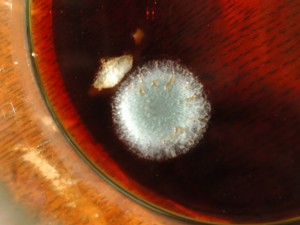Podcast: Play in new window | Download
Subscribe: RSS

A bloom of deadly aspergillus on a cup of coffee. There was a misunderstanding: it likes its surroundings hot and dry, not hot and black. (Photo by Albertstraub)
While maximizing its profits, industrial agriculture has unleashed many deadly, slow-gathering threats on humanity. The downsides of mechanistic, chemically intensive (and now, genetically mutilated) food manufacture (please don’t call it “farming”) — air pollution, water pollution, loss of topsoil, food contamination — have become relatively well known, if not much discussed or dealt with. Now it is becoming obvious that mono-culture and animal crowding have set loose a new set of killers — a lethal fungus and a set of deadly bacteria — that no one seems to know how to stop.
The newest bad actor here is the fungus aspergillus. (Take one of these for your headache, you won’t be calling in the morning.) Ingest a few grains of the mold’s deadly spores and if you don’t die right away from internal bleeding, or soon from jaundice, it will be later, from liver cancer.
Besides its deadly toxicity, the other thing that distinguished aspergillus is its preference for hot, dry weather. The current drought that is wilting the crops of the heartland is accelerating the spread and growth of this fungus.
Last year, more half the corn harvested in Missouri contained enough of the mold to be considered dangerous. According to a hair-igniting article in Scientific American this week, “Because the level of aflatoxins found in any given load of corn can be higher than the legal maximum, farmers are allowed to mix contaminated corn with safe corn to dilute the amount—but sometimes contaminants slip through the cracks.” Wow. Hard to see how any contaminants could slip through those cracks, how it could get out to kill cows, pets (it caused a national pet-food recall in 2007) and even farmed fish.
Meanwhile, people both in and out of hospitals are increasingly being preyed upon by so-called “superbugs,” infectious bacteria that are immune to antibiotics. This is another gift of industrial agriculture, which feeds antibiotics like hay to confined animals not treat illness, but to prevent it. The result is that the bacteria susceptible to the antibiotic die, while the one that are resistant — and there are always a few — thrive and emerge into the world.
Take, for example, methicillin-resistant Staphylococcus aureus (MRSA). By one estimate, in 2007 (it takes years, apparently, to add up the numbers) there were 880,000 MRSA infections in the United States. And that represents less than one-tenth of the superbug problem: there’s also vancomycin-resistant Enterococcus (VRE), Clostridium difficile, Klebsiella pneumoniae (it killed six people and wreaked havoc in the National Institutes of Health Clinical Center last year) and now gonorrhea. In the past year a resistant strain has moved front and center, and some fear within a few years gonorrhea will be untreatable.
Yes, there’s a fungus among us and there’s bug in our rugs. Together they amount to a gathering plague, given to us (like plague-infested blankets were given to Indians in another age) by our friendly “family farms.”
Tom: this is most enlightening and downright terrifying. Thanks for staying on top of these types of trends. The so called mainstream media certainly is not being diligent about keeping us informed. (The later fact remains mystifying.)
Michael Kastre
Thanks.